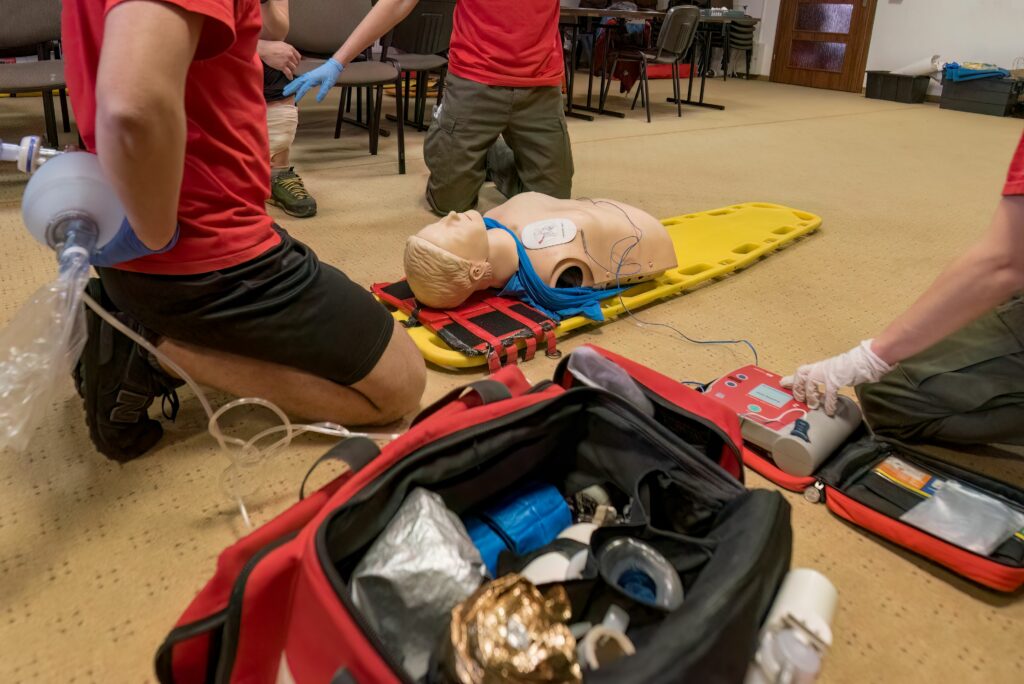Introduction
In moments of crisis, having the ideal tools can imply the difference between life and death. Cardiopulmonary resuscitation (CPR) is a crucial skill that everyone ought to learn, especially considering that it can save lives during emergencies. This is specifically real in Australia, where sudden cardiac events, sinking events, and sports-related cardiac arrests are regrettably typical. Past knowing exactly how to perform CPR, recognizing what essential CPR devices you should carry hand is similarly important. This short article looks into the essential tools and equipment required for efficient CPR First Aid Training near Melbourne practices in Australia.
Essential CPR Tools in Australia: What You Ought to Carry Hand
When it involves lifesaving steps like mouth-to-mouth resuscitation, having the ideal equipment conveniently available is an absolute need. The complying with items are necessary for any individual seeming gotten ready for emergencies:
1. Automated Outside Defibrillator (AED)
An AED is a mobile device that can analyze heart rhythms and provide an electric shock if required. It's crucial in cases of unexpected heart arrest.
- Benefits of AEDs: Quick access to an AED substantially increases survival rates. Where to Locate AEDs: Numerous public locations in Australia are geared up with AEDs, consisting of mall and schools.
How to Utilize an AED? Using an AED is uncomplicated:
Turn on the device. Attach pads to the client's bare chest. Follow voice motivates for analysis and shock delivery.2. Mouth-to-mouth Resuscitation Masks and Barriers
These devices secure both the rescuer and victim throughout mouth-to-mouth resuscitation.
- Types of Masks: Pocket masks with one-way shutoffs are preferred choices.
3. Emergency Treatment Kit
A comprehensive emergency treatment kit should include standard clinical materials like bandages, bactericides, handwear covers, and scissors.
- Contents of an Excellent First Aid Kit: Adhesive bandages Sterile gauze pads Antiseptic wipes Disposable handwear covers
4. Personal Protective Devices (PPE)
Gloves, masks, and face shields shield against infectious conditions during resuscitation efforts.
5. Training Manikins
Manikins are essential for practicing mouth-to-mouth resuscitation techniques properly and accurately.
- Importance of Practice: Routine training makes sure preparedness when actual emergencies occur.
6. Online Resources for Training
Accessing on-line training courses can assist acquaint yourself with both mouth-to-mouth resuscitation techniques and the most recent guidelines.
Understanding mouth-to-mouth resuscitation Techniques
Knowing exactly how to execute mouth-to-mouth resuscitation efficiently can significantly influence its success rate:
7. Just how to Do CPR?
CPR entails breast compressions and rescue breaths:
- Compression Depth: The correct compression depth for adults is about 5-6 cm.
Table: Compression Deepness Guidelines
|Age Group|Compression Depth|| ------------------|------------------|| Grownups|5-6 cm|| Kids (1-8)|4-5 centimeters|| Infants (<< 1 year)|3-4 cm|</p>
8. Infant CPR Technique
This technique differs considerably from grown-up treatments because of the delicacy of infants:
- Use two fingers for compressions at a depth of about 3-4 cm.
9. Advanced Resuscitation Skills
For doctor or those seeking innovative training, skills such as intubation or IV treatment may be necessary.
Special Circumstances in CPR
Certain situations require adjusted techniques or additional factors to consider:
10. Sports-Related Heart Arrests
Athletes may experience heart events in different ways because of physical exertion.
11. Drowning Victims
CPR techniques may need alteration based on water breathing results:
- Focus on rescue breathing before chest compressions.
Household CPR Readiness
Being prepared in your home can save lives throughout emergencies:
12. Producing a Family Members Emergency Plan
Discuss emergency procedures with relative regularly.
13. Saving Vital Equipment
Keep your first aid set, AED, and various other crucial gear quickly accessible at home.
Workplace Emergency situation Plans
Every office need to have a clear strategy concerning heart emergency situations:
14. Creating Work Environment Guidelines
Establish clear treatments for employee to follow during an emergency situation including cardiac arrest.
Local Resources for Educating and Certification
Taking action begins with education:
15. Regional Mouth-to-mouth Resuscitation Classes in Australia
Many organizations supply courses customized to various target markets-- be it parents or healthcare professionals.
List of Organizations Offering Classes
- St John Ambulance Red Cross Australia
16. On-line Mouth-to-mouth Resuscitation Qualification Courses in Australia
Online options make it easier than ever to discover vital lifesaving abilities at your very own pace.

Understanding Qualification Validity
Keeping your abilities present is equally as vital as knowing them at first:
17. Mouth-to-mouth Resuscitation Certificate Validity in Australia
Most qualifications call for revival every three years; check specific course needs for details.
FAQs
Q1: Just how frequently must I revitalize my CPR training?
It's advisable to freshen your abilities each to two years because of updates in standards or techniques.
Q2: Can anyone carry out CPR?
Yes! Any individual can execute hands-only mouth-to-mouth resuscitation regardless of their qualification condition; however, trained people will be more effective.

Q3: What's the distinction between grown-up and infant CPR?
The main distinction lies in compression depth and method utilized; grown-up compressions are deeper than infant compressions because of size differences.
Q4: Do I require unique devices for executing baby CPR?

Q5: Is it required to use rescue breaths throughout CPR?
While hands-only compression has actually been revealed effective for adults experiencing out-of-hospital heart attacks, rescue breaths stay essential throughout details scenarios like sinking occurrences or pediatric emergencies.
Q6: Where can I find local classes or qualification options?
Check community centers or companies like St John Rescue or Red Cross; they regularly offer classes throughout Australia!
Conclusion
Being prepared with crucial mouth-to-mouth resuscitation tools not only equips individuals but likewise cultivates a neighborhood prepared to react successfully throughout emergency situations. With resources offered throughout Australia-- from regional courses to online accreditations-- there's no excuse not to equip yourself with these lifesaving abilities. Bear in mind that finding out just how to do effective mouth-to-mouth resuscitation indicates being positive about safety-- not just for ourselves yet additionally for those around us who may eventually rely upon our readiness during a minute of crisis!